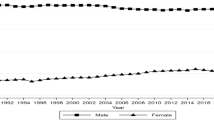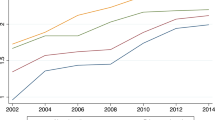Abstract
Public debates about the rise in top income shares often focus on the growing dispersion in earnings, and the soaring pay for top executives and financial-sector employees. But can the change in the marginal distribution of earnings on its own explain the rise in top income shares? Are top executives replacing capital owners in the group of top-income earners, or are we rather witnessing a fusion of top capital and top earnings? This paper proposes an extension of the copula framework and uses it for exploring the changing composition of top incomes. It illustrates that changes in top income shares can easily be decomposed into respective changes in the marginal distributions of labour and capital income and the changing association between the two types of income. An application using tax record data from Norway shows that the association between top labour and capital incomes grew stronger between 1995 and 2005 in the top half of the wage and capital income distribution, though it declined for the top 1% of capital income receivers. A gender decomposition demonstrates that the association of wage and capital incomes at the top is particularly striking for men, whilst women are largely under-represented in the top halves of the two marginal distributions.
Similar content being viewed by others
References
Aaberge, R.: Ranking intersecting Lorenz curves. Soc. Choice Welf. 33(2), 235–259 (2009)
Aaberge, R., Atkinson, A.B.: Top incomes in Norway. In: Atkinson, A.B., Piketty, T. (eds.) Top incomes: A global perspective. Oxford University Press, Oxford (2010)
Aaberge, R., Atkinson, A.B., Modalsli, J.: The ins and outs of top income mobility, Discussion Paper No. 762, Statistics Norway (2013)
Aaberge, R., Bjørklund, A., Jäntti, M., Pedersen, P.J., Smith, N., Wennemo, T.: Unemployment shocks and income distribution: how did the nordic countries fare during their crises?. Scand. J. Econ. 102, 77–99 (2000)
Alvaredo, F., Atkinson, A.B., Piketty, T., Saez, E.: The Top 1 percent in international and historical perspective. J. Econ. Perspect. 27(3), 3–20 (2013)
Arellano, M., Bonhomme, S.: Quantile selection models with an application to understanding changes in wage inequality. Econometrica 85(1), 1–28 (2017)
Atkinson, A.B.: The measurement of economic mobility. In: Eijgelshoven, P.J., van Gemerden, L.J. (eds.) Inkomensverdeling en openbare financiën, Het Spectrum, Utrecht, reprinted in A B Atkinson, 1983, Social justice and public policy, Chapter 3. Wheatsheaf Books, Brighton (1981)
Atkinson, A.B., Atkinson, A.B.: The distribution of top incomes in the United Kingdom 1908-2000. In: Piketty, T. (ed.) Top Incomes over the Twentieth Century. Oxford University Press, Oxford (2007)
Atkinson, A.B., Bourguignon, F.: The comparison of multi-dimensioned distributions of economic status. Rev. Econ. Stud. 49(2), 183–201 (1982)
Atkinson, A.B., Lakner, C.: Capital and labor: The factor income composition of top incomes in the United States, 1962-2006. World Bank Policy Research Working Paper, No. 8268 (2017)
Atkinson, A.B., Cassarico, A., Voitchovsky, S.: Top incomes and the gender divide. Journal of Economic Inequality. https://doi.org/10.1007/s10888-018-9384-z (2018)
Boland, P.J., Prochan, F.: Multivariate arrangement increasing functions with applications in probability and statistics. J. Multivar. Anal. 25, 286–298 (1988)
Bonhomme, S., Robin, J-M: Modelling individual earnings trajectories using copulas: France 1990–2002, Chapter 18. In: Bunzel, H., Christensen, B., Neumann, G., Robin, J.-M. (eds.) Contributions to Economic Analysis, Vol. 275: Structural Models of Wage and Employment Dynamics. Elsevier, Amsterdam (2006)
Bonhomme, S., Robin, J.-M.: Assessing the equalizing force of mobility using short panels: France 1990–2000. Rev. Econ. Stud. 76, 63–92 (2009)
Dardanoni, V., Lambert, P.: Horizontal inequity comparisons. Soc. Choice Welf. 18(4), 799–816 (2001)
Decancq, K.: Elementary multivariate rearrangements and stochastic dominance on a Fréchet class. J. Econ. Theory 147(4), 1450–1459 (2012)
Decancq, K.: Copula-based measurement of dependence between dimensions of well-being. Oxf. Econ. Pap. 66, 681–701 (2014)
García-Peñalosa, C., Orgiazzi, E.: Factor components of inequality: A cross-country study. Rev. Income Wealth, 59(4) (2013)
Gollin, D.: Getting income shares right. J. Polit. Econ. 110(2), 458–474 (2002)
Jäntti, M., Riihelä, M., Sullström, R., Tuomala, M.: Trends in top income shares in Finland. In: Atkinson, A.B., Piketty, T. (eds.) Top Incomes: A Global Perspective. Oxford University Press, Oxford (2010)
Johnson, D.G.: The functional distribution of income in the United States, 1850-1952. Rev. Econ. Stat. 36(2), 175–182 (1954)
Jäntti, M, Sierminska, E.M., Van Kerm, P.: Modelling the joint distribution of income and wealth. In: Measurement of Poverty, Deprivation and Economic Modelling, Emerald Group Publishing Limited, pp. 301–327 (2015)
Milanovic, B.: Increasing capital income share and its effect on personal income inequality. In: Boushey, H., DeLong, J.B., Steinbaum, M. (eds.) After Piketty: The Agenda for Economics and Inequality. Harvard University Press, Cambridge (2017)
Nelsen, R.B.: An Introduction to Copulas, 2nd edn. Springer Series in Statistics (2006)
Piketty, T., Saez, E.: Income inequality in the United States, 1913-1998. Q. J. Econ. 118(1), 1–39 (2003)
Piketty, T., Saez, E.: Income and wage inequality in the United Kingdom 1913-2002. In: Atkinson, A.B., Piketty, T. (eds.) Top Incomes over the Twentieth Century. Oxford University Press, Oxford (2007)
Piketty, T., Saez, E., Zucman, G.: Distributional National Accounts: Methods and Estimates for the United States. The Quarterly Journal of Economics (2018)
Roine, J., Waldenström, D.: The evolution of top incomes in an egalitarian society: Sweden, 1903–2004. J. Public Econ. 92(1–2), 366–387 (2008)
Schweizer, B., Wolff, E.F.: On nonparametric measures of dependence for random variables. Ann. Statist. 9(4), 879–885 (1981)
Tchen, A.H.: Inequality for Distributions with given marginals. Ann. Probab. 8, 814–827 (1980)
Wolff, E.N., Zacharias, A.: Household wealth and the measurement of economic well-being in the United States. J. Econ. Inequal. 7(2), 83–115 (2009)
Author information
Authors and Affiliations
Corresponding author
Additional information
Tony Atkinson sadly passed away in January 2017 before this paper could be finalised. Tony initiated this paper, and it would not exist without his passion and commitment. Subsequent revisions were carried out by the other two authors. The authors are grateful to Christoph Lakner, who contributed to the drafting of an earlier version of this paper and to Tom Wennemo for his help with preparing the empirical results. We are very grateful to Facundo Alvaredo, Cecilia García-Peñalosa, and two anonymous referees for helpful comments. The opinions expressed in the paper are those of the authors and do not necessarily represent the views of Statistics Norway, the OECD or its member countries.
Appendices
Appendix
A.1 The treatment of self-employment income
In our standard analysis, we allocate self-employment income to labour and capital income in shares two-thirds and one-third. Whilst this choice is largely uncontroversial when looking at aggregate income shares, it seems admittedly more ad hoc when studying the distribution of households’ or individuals’ incomes. In this appendix, we therefore provide some further details on the joint distribution of capital and self-employment incomes, and illustrate the impact of our results of simply ignoring income from self-employment.
Top capital and self-employment income shares are somewhat less strongly associated than those for capital and wage income. This can be seen in Table 10, where we compare the survival probabilities for the top income shares of capital and self-employment and capital and wage income. More specifically, the table gives the ratio of the joint survival probabilities – in these calculations, we no longer attribute income from self-employment to capital and wage income. Most of the values in Table 10 are lower than unity – this means that the cell sizes are smaller for the top capital and self-employment income shares than for the top capital and wage income shares. Especially the top 1% of capital income earners are more likely to be also amongst the top wage earners than amongst the top self-employment income receivers.
Since having high income from self-employment is positively associated with having high capital income, our decision to attribute self-employment income to capital and wage income rather than to ignore it in our analysis led to a boost in the association of top capital and wage incomes. Table 11 illustrates that the share of households in the top 1% of both capital and wage income that we have calculated is more than twice as high as it would be had we simply ignored income from self-employment. In other words, the association in top wage and capital income shares that we found was reinforced by the positive relationship between being in top part of these income distributions and having high income from self-employment.
Our time trend of a strengthening association of top capital and wage incomes is however not heavily affected by our decision to allocate income from self-employment to capital and wages. The observed difference in survival functions for top capital and wage incomes between 1995 and 2004/5 looks very similar if we ignore income from self-employment (Table 12). As in our standard analysis (Table 3), we find a strengthening in the association of top capital and wage incomes over time except for the top 1% of capital income earners – in fact, the strengthening becomes more visible once self-employment income is ignored.
A.2 A decomposition by age
Another way of decomposing the joint distribution of labour and capital incomes is to look at the contributions of the different age groups. Figure 4 shows the survival copulas for the top 10% of wage earners and capital income receivers, “sliced” for the top half of the capital and wage income distribution, respectively. Taxpayers in their late 40s to 50s are most strongly represented in the top 10% capital and wage income earners; persons above 70 are essentially not represented, since they typically do not make it into the upper half of the wage income distribution.
Rights and permissions
About this article
Cite this article
Aaberge, R., Atkinson, A.B. & Königs, S. From classes to copulas: wages, capital, and top incomes. J Econ Inequal 16, 295–320 (2018). https://doi.org/10.1007/s10888-018-9386-x
Received:
Accepted:
Published:
Issue Date:
DOI: https://doi.org/10.1007/s10888-018-9386-x





